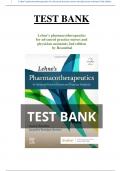Exam (elaborations)
Test Bank Lehne’s pharmacotherapeutics for advanced practice nurses and physician assistants 2nd edition by Rosenthal
Download Test Bank Lehne’s pharmacotherapeutics for advanced practice nurses and physician assistants 2nd edition by Rosenthal Test banks are a valuable resource for students all over the world, especially when you're running out of time and need a quick way to review material. They are also gre...
[Show more]



